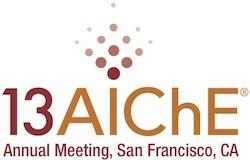
Two papers were proposed within the two CAPE-OPEN sessions at the AIChE 2013 Annual Meeting that were sponsored by CO-LaN and the Computing And Systems Technology (CAST) Division of AIChE. One paper was from DTU/CERE and one from ProSim/Fives Cryo. Since it was impossible to keep a session dedicated to CAPE-OPEN just for two papers, the Programming Chair for area 10E together with chairs of sessions sponsored by 10E, worked out the following solution: the paper from DTU/CERE has been transferred to session 10E01 and the paper from ProSim/Fives Cryo has been transferred to session 10E06.
Paper 441a titled “Dissemination of University Research through CAPE-OPEN” by B. Maribo-Mogensen, G. Kontogeorgis and A. Arya was presented on November 6, 2013.
Paper 710h titled “A New CAPE-OPEN Unit Operation Module for Simulation of Brazed Plate-Fin Heat Exchangers” by S. Dechelotte, O. Baudoin, A. Vacher, D. Averous, R. Egal, F. Picard, R. Sardeing was presented on November 7, 2013.
Abstract
Plate fin heat exchangers (PFHE) are frequently used in cryogenic process industries. During the last fifty years, several hundred thousand units have been manufactured and are now in operation all over the world. Their most commonly known application are in processes for air and natural gas separation. More recently, PFHE are now used in many other types of processes, e.g. separation of CO and H2, ammonia production, oil and gas processing, nuclear engineering, syngas production, etc. A main feature of these processes is the need for thermal integration: saving energy can be performed very efficiently by PFHE, in which heat exchange occurs between many streams simultaneously (cases with more than 12 streams are common).
ProSec software, used in the industry since the 1990’s, is the result of many years of research conducted with the Laboratoire de Génie Chimique (LGC) [1] and Fives Cryogenie [2], a leading manufacturer of this type of heat exchanger. This collaborative development provided a rigorous validation of the correlations used for the calculation of the heat exchange coefficients and pressure drops and, most of all, enabled the representation of the full complexity of this type of equipment. The ProSec software is powerful because:
It takes into account the complexity of all fluid and flow sequences,
The wall temperature is not assumed to be constant,
Numerical methods used allow the convergence of very complex industrial cases.
However, up to now such complex modeling was used as a stand-alone unit operation software while only very simplified models were used within process simulators. The development of a new version of ProSec software as a fully CAPE-OPEN compliant unit operation will be presented here. This new version allows the use of the full complexity of ProSec model within the simulation of a complete process with ProSimPlus, the general steady-state process simulator of ProSim [3], but also makes it readily available in other CAPE-OPEN simulation environments (AspenPlus, AspenHYSYS, ProII,…) thanks to their CAPE-OPEN compliance. This ability to interoperate with other programs will improve the everyday workflow of process engineers by avoiding the manual transfer of data between different tools. This to ensure full consistency and enhance the quality of results, particularly when PFHE are integrated into complex processes with several recycling streams. CAPE-OPEN capability will also give access to the full power of ProSec to companies using any CAPE-OPEN compliant process simulator.
References
[1] http://lgc.inp-toulouse.fr
[2] www.fivesgroup.com/fivescryogenie/en/Pages/Home.aspx
[3] www.prosim.net
